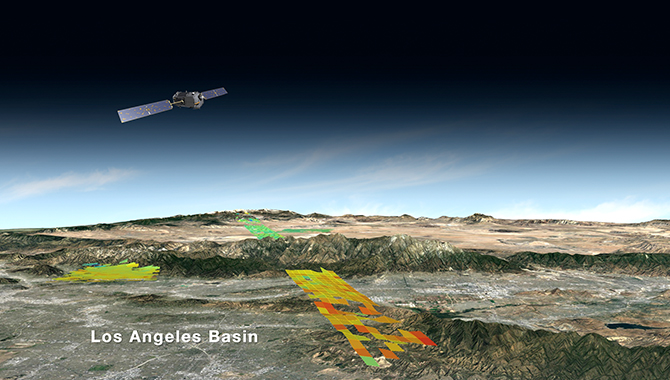
NASA’s OCO-2 satellite flies around the globe taking approximately 100,000 measurements of CO2 concentrations each day. This illustration depicts an OCO-2 data collection over the Los Angeles Basin.
Image Credit: NASA/JPL-Caltech
NASA’s Orbiting Carbon Observatory 2 (OCO-2) has enabled scientists to answer key questions about extreme weather events and atmospheric carbon dioxide (CO2) levels.
OCO-2 is a novel NASA mission designed to examine global CO2 sources and “sinks”: places such as oceans and forests where the greenhouse gas is removed from the atmosphere. Concentrations of CO2 in the atmosphere change from season to season as plants grow and die. The highest concentrations are seen during the Northern Hemisphere’s winter, while the lowest levels occur in the Northern Hemisphere’s summer.
“The size of the seasonal cycle and annual increase are determined by a delicate balance between the earth’s atmosphere, ocean, and land. Each year, a different amount of carbon dioxide is taken up and released by the ocean, and by the plants and trees,” said Annmarie Eldering, OCO-2 Deputy Project Scientist at the Jet Propulsion Laboratory (JPL), during a discussion about recently published research based on data from OCO-2. “In some years, these natural processes remove as little as 20% of the human emissions, while sometimes they scrub as much as 80%.”
A key area of scientific interest concerns the relationship between El Nino weather events and increases in atmospheric CO2 concentrations. Launched on July 2, 2014, OCO-2 was able to measure the effects of the 2015/2016 El Nino weather event on tropical forests in South America, Africa, and Asia, which play critical roles in removing CO2 from the atmosphere. As the El Nino significantly altered weather patterns across the globe—especially in the tropics—OCO-2 was in a unique position to detect the subsequent changes in regional and temporal distribution of CO2 in the atmosphere.
“OCO-2 has given us two different, revolutionary new ways to understand the effects of drought and heat on tropical forests,” said Scott Denning, Professor of Atmospheric Science at Colorado State University. “[T]he instrument directly measures CO2 over these regions thousands of times every day, and also senses the rate of photosynthesis by detecting fluorescent chlorophyll in the trees themselves.”
During 2015 and 2016, OCO-2 instruments detected the largest annual increase in atmospheric CO2 in at least 2000 years. The increase for each year was 6.3 gigatons of carbon, which is roughly three parts per million of CO2 in the atmosphere. That is considerably greater than the typical annual increase, which is closer to four gigatons.
“So what caused this unprecedented increase?” asked Eldering. “[T]hanks to OCO-2, which from its vantage point in space is able to make roughly 100,000 measurements per day across the globe, we can answer such questions.”
Observations from OCO-2 confirmed that heat and drought caused by the 2015/2016 El Nino were primary contributors to the record increase in atmospheric CO2 concentrations around the world. Scientists—including Eldering and JPL research scientist Junjie Liu—compared the El Nino time frame to 2011, when temperature and rainfall were normal over tropical forests and the tropical terrestrial biosphere was virtually carbon neutral.
“The OCO-2 satellite allowed our team to quantify how the net exchange of carbon between land and atmosphere in each tropical region was affected by the 2015/2016 El Nino,” said Liu, lead author of a ground-breaking research paper based on OCO-2 data that was published on October 13, 2017, in the journal Science.
Liu and other scientists determined that during the El Nino event in 2015 and 2016, three tropical land regions in South America, Africa, and Asia released 2.5 gigatons more carbon into the atmosphere than in 2011. Although the cause of the increase in CO2 release differed from region to region—drought and heat in eastern and southeastern South America, heat in tropical Africa, and fires resulting from land clearing, drought, and heat in Indonesia—each was a by-product of El Nino effects.
Before OCO-2, gathering this kind of definitive information on the relationship between El Nino events and global CO2 concentrations was difficult, if not impossible.
“I’ve been working on this problem for more than 25 years, and this is the first time we’ve ever had data like these for the tropical forest,” said Denning. He added, “The OCO-2 observations revealed the cause: the impact of El Nino heat and drought on tropical forests in these three regions.”
Scientists will continue to use observations from OCO-2 to measure changes in atmospheric CO2 concentrations across the globe. In the meantime, NASA is working toward the launch of a new carbon observatory: OCO-3. This mission will utilize the flight-spare instrument from OCO-2, adapting it to fly on the International Space Station (ISS). It will increase the agency’s ability to take data at more times and in more places. Together, OCO-2 and OCO-3 will advance scientific understanding of how normal and extreme weather events affect tropical forests, which are key “sinks” for CO2, and how climate and ecosystems around the globe interact.
Read an APPEL News article about the launch of OCO-2.
Download an APPEL case study about the mission: OCO-2: A Second Chance to Fly.
Explore the OCO-2 mission.
Find out about OCO-3.









